|
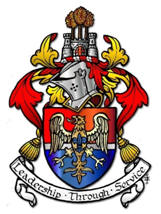
PRINT Version
of this article
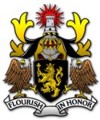
Link to
The American
College of Heraldry

Link to
Burkes Peerage and
Gentry International Register of Arms

Link to
College of Arms
(UK)
Back to


|
Heraldry
in its most general sense encompasses all matters relating to the
duties and responsibilities of
officers of arms.
To most, though, heraldry is the practice of designing, displaying,
describing and recording
coats of arms
and
badges. The
origins of heraldry lie in the need to distinguish participants in
combat when their faces were hidden by iron and steel
helmets.
Origins and
History
At
the time of the
Norman Conquest
of England, modern heraldry had not yet been developed. The beginnings
of modern heraldic structure were in place, but would not become
standard until the middle of the twelfth century. By the early
thirteenth Century, coats of arms were being inherited by the children
of
armigers.
In Britain the practice of using marks of
cadency
arose to distinguish one son from another, and was institutionalized and
standardized by the
John Writhe
in the fifteenth century.
In the late
Middle Ages
and the
Renaissance,
heraldry became a highly developed discipline, regulated by professional
officers of arms. As its use in jousts became obsolete coats of arms
remained popular for visually identifying a person in other
ways—impressed in
sealing wax
on documents, carved on family tombs, and flown as a banner on country
homes.
From the
beginning of heraldry, coats of arms have been executed in a wide
variety of media, including on paper, painted wood,
embroidery,
enamel,
stonework,
stained glass,
and computerized media. For the purpose of quick identification in all
of these, heraldry distinguishes only seven basic
colors and
makes no fine distinctions in the precise size or placement of
charges on
the field. Coats of arms and their accessories are described in a
concise
jargon
called
blazon.
This technical description of a coat of arms is the standard that must
be adhered to no matter what artistic interpretations may be made in a
particular depiction of the arm
The idea that
each element of a coat of arms has some specific meaning is unfounded.
Though the original armiger may have placed particular meaning on a
charge, these meanings are not necessarily retained from generation to
generation. Unless the arms incorporate an obvious pun on the bearer's
name, it is difficult to find meaning.
The development
of
firearms
made
plate armor
obsolete and heraldry became detached from its original function. This
brought about the development of "paper heraldry" that only existed in
paintings. Designs and shields became more elaborate at the expense of
clarity. The 20th century's taste for stark iconic emblems made the
simple styles of early heraldry fashionable again.
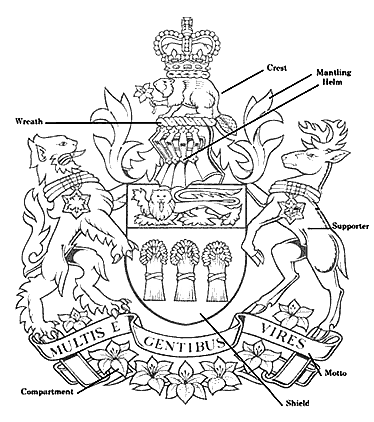
The Rules of Heraldry
Shield and Lozenge
The
focus of modern heraldry is the armorial achievement, or
coat of arms.
The central element of a coat of arms is the
shield. In
general the shape of shield employed in a coat of arms is irrelevant.
The fashion for shield shapes employed in heraldic art has generally
evolved over the centuries. There are times when a particular shield
shape is specified in a blazon.
Traditionally,
as women did not go to war, they did not use a shield. Instead their
coats of arms were shown on a
lozenge—a
rhombus
standing on one of its acute corners. This continues to hold true in
much of the world, though some heraldic authorities make exceptions. In
Canada the restriction against women bearing arms on a shield has been
completely eliminated. Noncombatant
clergy have
also made use of the lozenge as well as the cartouche—an
oval-shaped
vehicle for their display.
Tinctures are the colors used in heraldry. Since heraldry is
essentially a system of identification, the most important
convention of heraldry is the
rule of
tincture. To provide for contrast and visibility
metals—generally lighter tinctures—must never be placed on
metals and colors—generally darker tinctures—must never be
placed on colors. There are instances where this cannot be help,
such as where a
charge
overlays a partition of the field. Like any rule, this admits
exceptions, the most famous being the arms chosen by
Godfrey of
Bouillon when he was made
King of
Jerusalem.
The
names used in English blazon for the tinctures come mainly from
French
and include
Or
(gold),
Argent
(white),
Azure
(blue),
Gules
(red),
Sable
(black),
Vert
(green), and
Purpure
(purple). A number of other colors are occasionally found,
typically for special purposes.
Besides
tinctures, certain patterns called
furs
can appear in a coat of arms. The two common furs are
ermine
and
vair.
Ermine represents the winter coat of the
stoat,
which is white with a black tail. Vair represents a kind of
squirrel with a blue-gray back and white belly sewn together it
forms a pattern of alternating blue and white shapes.
Heraldic charges can also be displayed in their natural colors.
Many natural items such as plants and animals are described as
proper in this case. Proper charges are very frequent as crests
and supporters. It is considered bad form to use proper as a
method of circumventing the tincture convention.
Division of the Fields
The
field
of a
shield
in heraldry can be divided into more than one
tincture,
as can the various
heraldic
charges. Many coats of arms consist simply of a
division of the field into two contrasting tinctures. Since
these are considered divisions of a shield the
rule of
tincture can be ignored. For example, a shield
divided azure and gules would be perfectly acceptable. A line of
partition may be straight or it may be varied. The variations of
partition lines can be wavy, indented, embattled, engrailed, or
made into myriad other forms.
Ordinaries
In the
early days of heraldry, very simple bold rectilinear shapes were
painted on shields. These could be easily recognized at a long
distance and could also be easily remembered. They therefore
served the main purpose of heraldry—identification. As more
complicated shields came into use, these bold shapes were set
apart in a separate class as the "honorable ordinaries." They
act as charges and are always written first in
blazon.
Unless otherwise specified they extend to the edges of the
field. Though ordinaries are not easily defined, they are
generally described as including the
cross,
the
fess,
the
pale,
the
bend,
the
chevron,
the
saltire,
and the
pall.
There is also a
separate class of charges called sub-ordinaries which are of geometrical
shape subordinate to the ordinary. According to Friar, they are
distinguished by their order in blazon. The sub-ordinaries include the
inescutcheon,
the
orle, the
tressure,
the double tressure, the
bordure,
the
chief, the
canton, the
label, and
flaunches.
Ordinaries may
appear in parallel series, in which case English blazon gives them
different names such as pallets, bars, bendlets, and chevronels. French
blazon makes no such distinction between these diminutives and the
ordinaries when borne singly. Unless otherwise specified an ordinary is
drawn with straight lines, but each may be indented, embattled, wavy,
engrailed, or otherwise have their lines varied.
Charges
A
charge is any object or figure placed on a heraldic shield or on any
other object of in an
armorial composition.
Any object found in nature or technology may appear as a heraldic charge
in armory. Charges can be animals, objects, or geometric shapes. Apart
from the ordinaries, the most frequent charges are the
cross—with
its hundreds of variations—and the
lion and
eagle.
Other common animals are
fish,
martlets,
griffins,
boars, and
stags.
Dragons,
unicorns,
and more exotic monsters appear as charges but also as
supporters.
Animals are
found in various stereotyped positions or attitudes.
Quadrupeds
can often be found rampant—standing on the left hind foot. Another
frequent position is passant, or walking, like the lions of the
Coat of Arms of
England. Eagles are almost always shown with their wings
spread, or displayed.
In
English heraldry
the
crescent,
mullet,
martlet,
annulet,
fleur-de-lis,
and
rose may be
added to a shield to distinguish
cadet
branches of a family from the senior line. These cadency marks are
usually shown smaller than normal charges, but it still does not follow
that a shield containing such a charge belongs to a cadet branch. All of
these charges occur frequently in basic undifferenced coats of arms.
Marshalling
Marshalling is the art of correctly arranging armorial bearings. Two or
more coats of arms are often combined in one shield to express
inheritance, claims to property, or the occupation of an office.
Marshalling can be done in a number of ways, but the principal modes of
include impalement and dimidiation. This involves using one shield with
the arms of two families or corporations on either half. Another method
is called quartering, in which the shield is divided into quadrants. One
might also place a small inescutcheon of a coat of arms on the main
shield.
When more than
four coats are to be marshalled, the principle of quartering may be
extended to two rows of three (quarterly of six) and even further. A few
lineages have accumulated hundreds of quarters, though such a number is
usually displayed only in documentary contexts. Some traditions have a
strong resistance to allowing more than four quarters, and resort
instead to sub-quartering.
Helm and Crest
In
English the word "crest" is commonly used to refer to a coat of arms—an
entire heraldic achievement. The correct use of the heraldic term
crest
refers to just one component of a complete achievement. The crest rests
on top of a
helmet
which itself rests on the most important part of the achievement—the
shield. The crest is usually found on a
wreath of
twisted cloth and sometimes within a coronet. The modern crest has
evolved from the three-dimensional figure placed on the top of the
mounted knights' helms as a further means of identification. In most
heraldic traditions a woman does not display a crest, though this
tradition is being relaxed in some heraldic jurisdictions.
When the helm
and crest are shown, they are usually accompanied by a
mantling.
This was originally a cloth worn over the back of the helmet as partial
protection against heating by sunlight. Today it takes the form of a
stylized cloak or hanging from the helmet. Typically in British
heraldry, the outer surface of the mantling is of principal color in the
shield and the inner surface is of the principal metal. The mantling is
conventionally depicted with a ragged edge, as if damaged in combat.
Clergy often
refrain from displaying a helm or crest in their
heraldic achievements.
Members of the
Roman Catholic
clergy may display appropriate headwear. This takes the form of a
galero with
the colors and tassels denoting rank. In the
Anglican
tradition, clergy members may pass crests on to their offspring, but
rarely display them on their own shields.
Mottoes
An
armorial
motto is a
phrase or collection of words intended to describe the motivation or
intention of the armigerous person or corporation. This can also form a
pun on the family name as in the
Neville
motto "Ne vile velis." Mottos are generally changed at will and do not
make up an integral part of the armorial achievement. Mottoes can
typically be found on a scroll under the shield. In
Scottish heraldry
where the motto is granted as part of the blazon, it is usually shown on
a scroll above the crest. A motto may be in any language.
Supporters and
Other Insignia
Supporters
are human or animal figures placed on either side of a coat of arms as
though supporting it. In many traditions, these have acquired strict
guidelines for use by certain social classes. On the European continent,
there are often less restrictions on the use of supporters. In Britain
only
peers of
the realm, senior members of orders of knighthood, and some corporate
bodies are granted supporters. Often these can have local significance
or a historical link to the armiger.
If the armiger
has the title of
baron,
hereditary
knight, or
higher, he or she may display a coronet of rank above the shield. In
Britain this is usually below the helmet, though it is often above the
crest in Continental heraldry.
Another
addition that can be made to a coat of arms is the insignia of an order
of knighthood. This is usually represented by a collar or similar band
surrounding the shield. When the arms of a knight and his wife are shown
in one achievement, the insignia of knighthood surround the husband's
arms only, and the wife's arms are customarily surrounded by a
meaningless ornamental garland of leaves for visual balance.
Modern Heraldry
Heraldry continues to flourish today in the modern day. Institutions,
companies, and members of the public may obtain officially recognized
coats of arms from governmental heraldic authorities. However, many
users of modern heraldic designs do not register with heraldic
authorities, and some designers do not follow the rules of heraldic
design at all.
In Scotland the
control of heraldry is fully legal and the
Lord Lyon King of Arms
retains powers—including imprisonment, fines, and defacement of
illegitimate arms. His office has no equivalent in England and is closer
to that of the
Earl Marshal
than that of
Garter Principal King
of Arms.
The
Heineman Arms
The
Heineman Armorial Bearings are registered to Wilhelm August Heineman,
late of Keokuk, Lee County, Iowa; the son of John Henry Heineman and
Bertha Ann Heineman, nee Burger; recognized 16 January 1999 and entered
in the Heraldic Register (American College of Heraldry) under Number
1778.
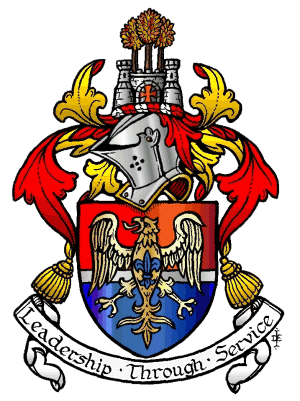
The
blazon for the Heineman Armorial Bearings is as follows:
Per fess Gules and Azure
a barrulet Argent, over-all an eagle displayed wings inverted Or,
charged on the breast with a fleur-de-lis Azure. Above the Shield is
placed a Helmet with a Mantling Gules doubled Or, and on a Wreath Or and
Gules is set for Crest, a castle with two towers Argent the port
occupied by a cross throughout Gules, and issuing there above three
trees in Autumn tinctures Proper, and in an Escrol below the Shield this
Motto: Leadership Through Service.
The Shield
A "fess"
is associated with the military girdle and belt of the ancients and
their nobility. The red, white, and blue shield colors were chosen to
signify American service. The eagle has a number of meanings. The
surname Jensen is a variant of the "son of Jens" or the "son of John."
Usually this has an ancient allusion to respect for St. John, who is
represented by the eagle in ancient and modern religious iconography.
The eagle with turned-down wings alludes to Germanic ancestry. The
fleur-de-lis on a golden background (a reversal of the ancient French
flag colors) alludes to Wilhelm's military service for the United States
in France as part of the Allied Forces during WWI. The fleur-de-lis is
representative of the Crum family origins. The fleur-de-lis is an
adaptation of the lily, generally recognized as one of the most highly
regarded charges with those of royalty and nobility. The three leaves
of the fleur-de-lis represent courage, faith, and wisdom.
The Helm
The
proper helmet of a gentleman's coat of arms is the "tilting" helm.
The Crest
A wreath
or torce is common in
early arms. The castle in the crest alludes to the Burger (meaning
dweller in a castle or town). Growing from the castle is a grove of
trees, alluding to the Heineman name meaning a man who lives in or
protects a grove or forest. The trees are in Autumn colors to keep from
clashing with the other tinctures. The cross on the castle port is of
Germanic design referring to the Christian faith.
The Motto
The motto
represents the family's dedication to service organizations and their
leadership roles.
Rightful Bearers of the Arms
The bearer of
a coat of arms is called the Arminger (Wilhelm August Heineman) and the
arms are passed to the male heirs in direct lineage. The following
individuals have rightful use of these arms: Lucille Ann Dodson, Peter
Edward Heineman, Sharen Lee Heineman, Bim August Heineman, Peter Lea
Heineman, Chad August Heineman.
Ancestral Arms
The
following are representative of some of the coat of arms used by
ancestors of the Heineman family.
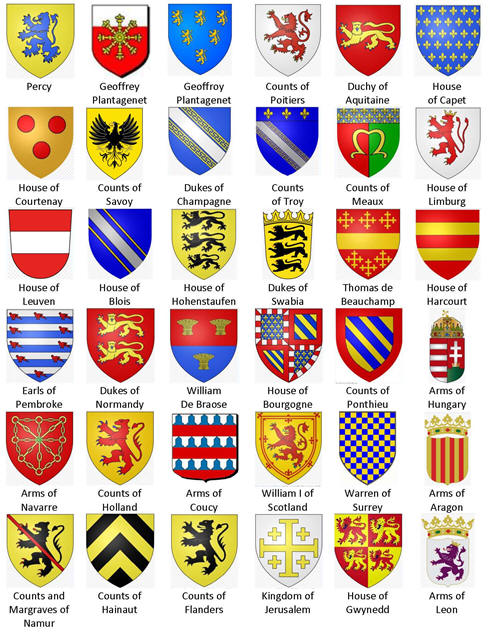
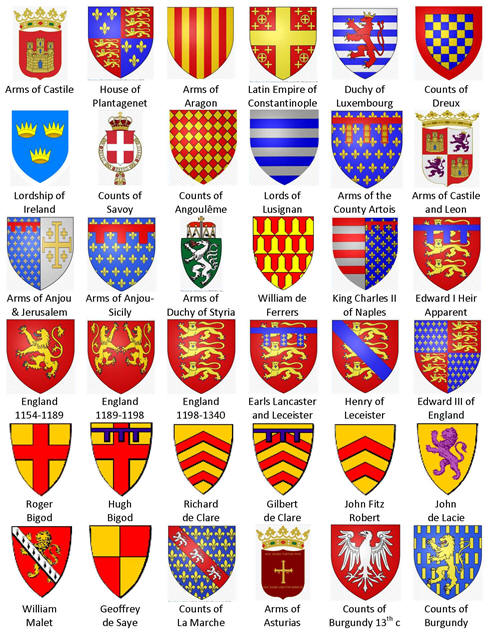
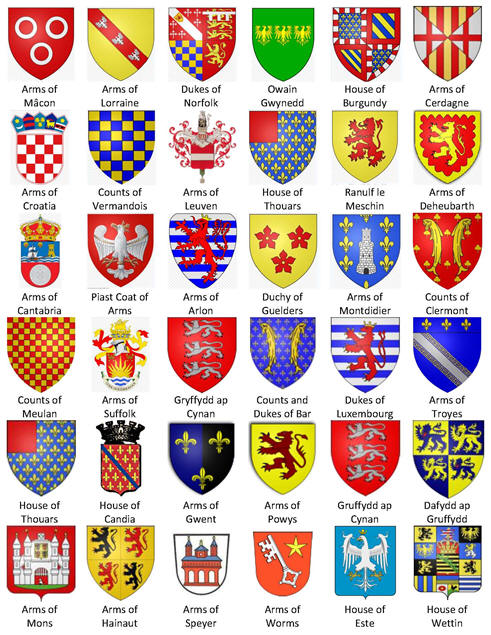
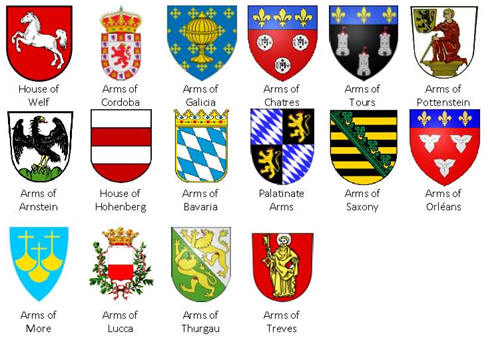

|